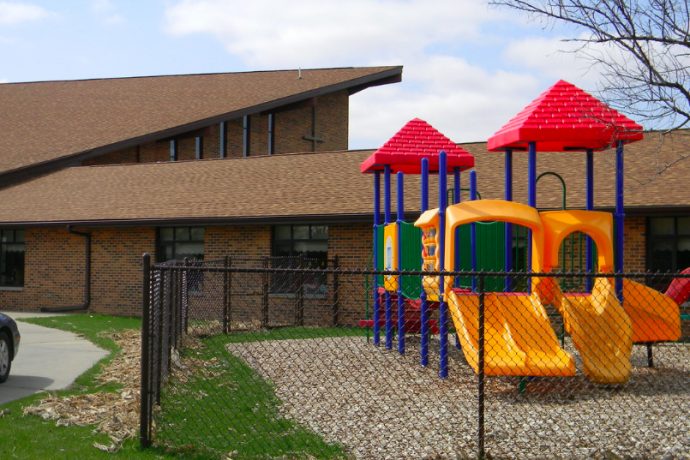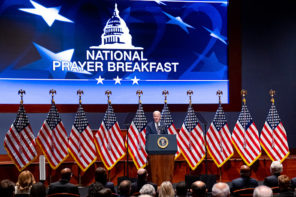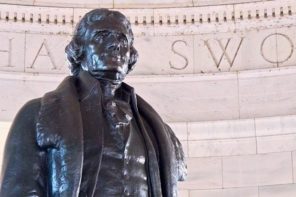On Monday, the Supreme Court took a dramatically new approach to the First Amendment, though you wouldn’t have known it from reading the brief, oversimplified opinion. In Trinity Lutheran Church of Columbia, Inc. v. Comer the Court held that—at least in some circumstances—the Free Exercise Clause of the First Amendment requires governments to provide taxpayer funds to churches. This newfound requirement is something the dissent argued should, in fact, be prohibited under the First Amendment’s Establishment Clause.
I have previously written about the facts of Trinity Lutheran, as has RD, but they warrant a brief revisiting here. A Missouri state program offered grants for a limited number of nonprofit schools and daycares to purchase rubber playground surfaces made from recycled tires. Prospective grantees were evaluated and selected based on a number of factors, including poverty level of the surrounding area and their willingness to generate media exposure for Missouri. In 2012, Trinity Lutheran, a Missouri Synod congregation, applied for the grant to renovate the playground of a preschool owned and operated by the church. While it ranked highly, Trinity Lutheran was denied the grant because of a department policy that made houses of worship ineligible for funds. Upon learning the reason for their denial, Trinity Lutheran sued, arguing that the department policy violated their religious rights.
Typically, First Amendment cases involving government funding of religious organizations present Establishment Clause questions—with plaintiffs arguing that the state is prohibited from providing taxpayer money to a church. In fact, the Court has long held that it is unconstitutional for governments to directly subsidize religious activities. Trinity Lutheran, in contrast, asked whether the denial of funds to houses of worship may also be unconstitutional.
Shockingly, the court answered in the affirmative, finding that the Missouri policy violated Trinity Lutheran’s free exercise rights by forcing the church to choose between its religious identity and participation in a government benefit program. In an opinion by Chief Justice Roberts, the Court held “the Department’s policy expressly discriminates against otherwise eligible recipients by disqualifying them from a public benefit solely because of their religious character… such a policy imposes a penalty on the free exercise of religion that triggers the most exacting scrutiny.” The Court further held that Missouri’s stated reason for the policy—to avoid potential Establishment Clause violations—was insufficient.
The Court’s opinion stands in stark opposition to earlier religious funding decisions, and especially its 2004 opinion in Locke v. Davey. In Locke, the Court upheld a state scholarship program that prohibited recipients from using the funds to pursue a degree in devotional theology. The Court attempted to distinguish Trinity Lutheran from Locke by relying on a distinction between religious identity and religious activities. It explained, “Davey was not denied a scholarship because of who he was; he was denied a scholarship because of what he proposed to do—use the funds to prepare for the ministry. Here there is no question that Trinity Lutheran was denied a grant simply because of what it is—a church.”
How government agencies administering grant programs are expected to distinguish between a house of worship’s religious identity and its religious activities is a spectacularly difficult (if not impossible) task that’s entirely ignored by the Court. Making such a distinction is now constitutionally essential, however, as programs must navigate between not funding religious activities, lest they violate the Establishment Clause, and not “discriminating” against religious institutions, lest they violate the Free Exercise Clause. Previously, state programs could safely avoid such perilous questions by simply declining to fund houses of worship. Trinity Lutheran throws such policies into question—although the scope of the ruling is unclear. (More on that later.)
Both Justice Gorsuch in concurrence and Justice Sotomayor in dissent criticized the majority’s attempt to create a line between religious identity and activities, though they ultimately arrive at opposing conclusions. Gorsuch asked, “Can it really matter whether the restriction in Locke was phrased in terms of use instead of status (for was it a student who wanted a vocational degree in religion? Or was it a religious student who wanted the necessary education for his chosen vocation?).”
Similarly, in her Trinity Lutheran dissent, Sotomayor wrote, “the Church has a religious mission, one that it pursues through the [preschool]. The playground surface cannot be confined to secular use any more than lumber used to frame the Church’s walls, glass stained and used to form its windows, or nails used to build its altar.” But while Gorsuch’s opinion suggests that he would support even direct state subsidization of religious activities, Sotomayor argued that directly subsidizing a house of worship—even for ostensibly non-religious expenses such as playground surfaces—is proscribed by the Establishment Clause.
It’s notable that the Court has previously declined to require religious organizations to distinguish between their religious and secular activities. A 1987 decision, Corporation of the Presiding Bishop v. Amos, involved an Establishment Clause challenge to a religious exemption that permitted religious organizations to hire employees based on their faith, even for secular jobs such as janitorial work. The plaintiff in that case argued that while the exemption was justified for employees with religious duties, it was unconstitutional when applied to employees with purely secular jobs.
The Court disagreed, finding that creating such a constitutional line would be untenable. It held, “It is a significant burden on a religious organization to require it, on pain of substantial liability, to predict which of its activities a secular court will consider religious. The line is hardly a bright one.” Thus, the Amos Court declined to adopt a constitutional bright line between religious and secular activities in order to grant religious organizations advantageous exemptions. However in Trinity Lutheran, it relies on precisely such a distinction in order to permit (indeed, require) state funding of houses of worship.
As a more general matter, it is suspect that the majority opinion decries treating houses of worship as different from secular organizations, when the Court has repeatedly relied on this difference to grant exemptions to faith-based organizations that are unavailable to secular nonprofits. As Justice Sotomayor explains, “the government may draw lines on the basis of religious status to grant a benefit to religious persons or entities but it may not draw lines on that basis when doing so would further the interests the Religion Clauses protect in other ways. Nothing supports this lopsided outcome.”
The only saving grace (so to speak) of the opinion is buried in a footnote, though how lower courts will interpret both its weight and substance is unclear. The footnote states, “this case involves express discrimination based on religious identity with respect to playground resurfacing. We do not address religious uses of funding or other forms of discrimination.” Two of the six justices who signed the majority opinion—Gorsuch and Thomas—dissented from the footnote, though Justice Breyer, who concurred only in the judgment, appears to support it.
More importantly, it’s far from clear how literally to interpret the footnote’s apparent attempt to confine the decision exclusively to programs involving playground resurfacing. Justice Gorsuch explained in his concurrence that lower courts might (in his view, mistakenly,) “read it to suggest that only ‘playground resurfacing’ cases, or only those with some association with children’s safety or health, or perhaps some other social good we find sufficiently worthy, are governed by the legal rules recounted in . . . the Court’s opinion.” While this narrow reading of the case would limit the damage it inflicts on the Establishment Clause, it seems likely that at least some courts will interpret the decision far more broadly, and sanction a variety of programs providing direct funding to houses of worship.
Regardless of how the footnote is interpreted, the Court’s opinion in Trinity Lutheran demonstrates a fundamental misunderstanding of the purpose of the religion clauses, and effectively ignores the danger of using public coffers to subsidize houses of worship. The majority describes this as a case about religious discrimination, which demonstrates how successful the religious right has been at rebranding nearly any attempt to enforce the Establishment Clause as a form of religious persecution. Declining to divert public money to churches has long been considered necessary to protect the individual right of conscience of the citizenry. Far from being discriminatory, separation of church and state is intended to ensure that individuals may choose to adhere to any or no religious beliefs free from coercion, and that the church itself is protected from government intrusion. The majority opinion ignores the long history of and important justifications for prohibiting state subsidization of houses of worship. Hopefully, its damage will be confined to the unusually sympathetic facts of this case.





